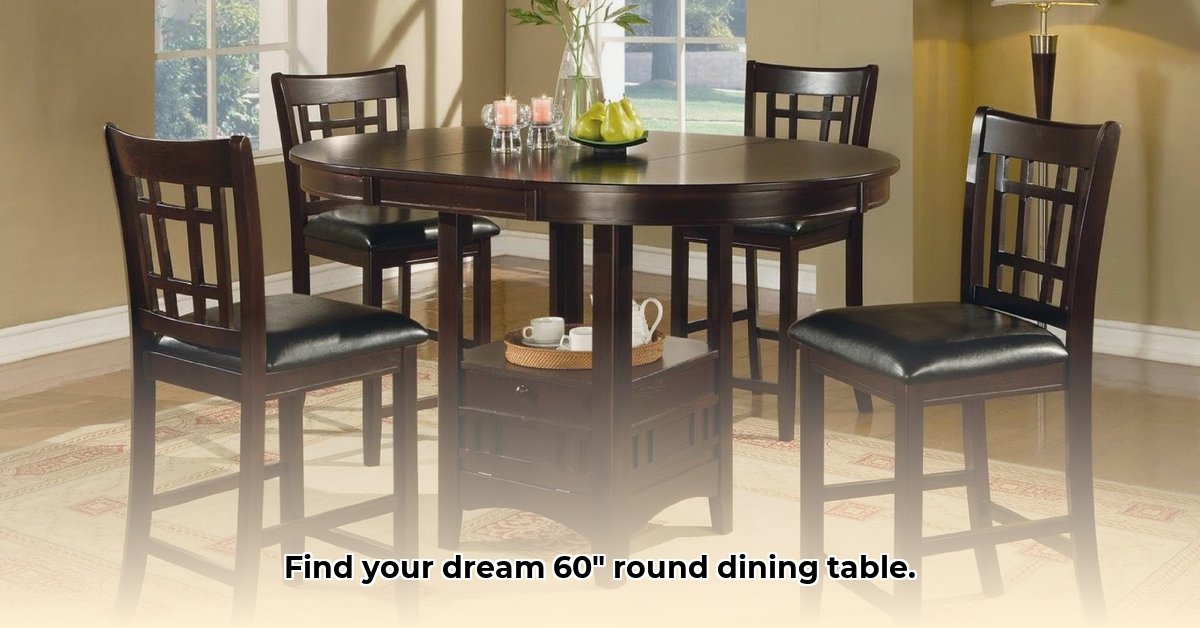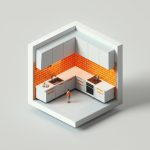Choosing a new dining table can be an exciting yet overwhelming task. This guide simplifies the process of finding the perfect 60-inch round dining table, covering materials, styles, seating capacity, budget considerations, and essential maintenance tips. Our aim is to ensure you discover a table that not only meets your needs but also enhances your dining space for years to come. For tables with expandable seating, check out these round tables with leaves.
60-Inch Round Dining Table: Your Comprehensive Guide
The quest for the ideal 60-inch round dining table involves numerous factors. This comprehensive guide provides insights into various styles, materials, and price ranges, empowering you to make an informed decision and select the perfect centerpiece for your dining area. Let’s delve into the key elements that will help you choose the best round dining table for your home.
Material Selection: A Comprehensive Exploration
The choice of material profoundly impacts your table’s aesthetic appeal, durability, and overall cost. Selecting the right material ensures long-term satisfaction and a dining table that stands the test of time. Which dining table material aligns best with your lifestyle and preferences?
1. The Enduring Allure of Wood: Solid wood tables embody timeless elegance and offer a classic touch to any dining space. Oak is celebrated for its exceptional durability, versatility, and beautiful aging process. Mahogany exudes sophistication and refinement with its rich, reddish-brown hue. Walnut presents a darker, more dramatic aesthetic, adding depth and character to your dining area. However, solid wood requires consistent maintenance, including regular polishing and occasional refinishing, to prevent scratches, water damage, and warping. Prices typically range from several hundred to several thousand dollars, depending on the wood species, quality, and craftsmanship. This choice significantly influences your broader dining room furniture selection.
Pros of Wood:
- Timeless elegance that enhances the ambiance of any dining space.
- Exceptional durability (depending on the wood type), ensuring longevity.
- Adds natural warmth to the room, creating an inviting and cozy atmosphere.
- Offers a wide range of finishes and styles to match various decor preferences.
Cons of Wood:
- Demands regular maintenance to prevent damage from spills, scratches, and humidity.
- Susceptible to scratches, dents, and water damage if not properly cared for.
- Can be a significant investment, particularly for premium hardwoods, impacting your budget.
2. The Contemporary Edge of Metal: Metal dining tables, often constructed from steel or iron, introduce a sleek, modern, or industrial vibe to your dining space. These tables are renowned for their durability and ease of cleaning, making them a practical choice for busy households. Powder-coating enhances their visual appeal by adding extra protection and customizable color options. However, metal tables may be prone to dents or scratches and can feel cold to the touch, especially in colder climates. Metal tables generally fall within a mid-range price bracket, offering a compelling combination of style and affordability, thereby influencing decisions about modern dining furniture.
Pros of Metal:
- Exceptional durability, ensuring long-lasting use and resistance to wear and tear.
- Effortless to clean, simplifying maintenance and upkeep.
- Provides a modern aesthetic that seamlessly complements contemporary decor styles.
- Resistant to many common household stains and spills.
Cons of Metal:
- Susceptible to dents and scratches, necessitating careful handling and protection.
- Can feel cold to the touch, potentially requiring warmer accents like placemats or a tablecloth.
- Some designs can be quite heavy, making it challenging to move or reposition the table.
- Limited options for refinishing or repairing significant damage.
3. The Refined Sophistication of Glass: Glass-topped tables impart a sense of modern elegance and airiness to any dining area, usually paired with complementary metal or wood bases. The smooth surface is remarkably easy to clean, but the glass can shatter under significant impact. Therefore, tempered glass, which is substantially stronger and safer than standard glass, is an essential safety feature. Glass tables typically occupy a mid-range price point, offering a blend of style and value. Is a glass table a practical and safe option for your family’s needs and lifestyle?
Pros of Glass:
- Creates a sleek and modern look, enhancing the visual appeal of your dining area.
- Extremely easy to clean, simplifying post-meal maintenance and upkeep.
- Visually expands the space, generating an open and airy atmosphere.
- Allows light to pass through, brightening the room and creating a sense of spaciousness.
Cons of Glass:
- Potential to shatter (unless tempered), posing safety risks, especially in households with children.
- Displays fingerprints and smudges readily, requiring frequent cleaning and polishing.
- Can be quite heavy, making it difficult to move or reposition without assistance.
- May not be as durable as wood or metal, requiring careful handling to prevent chips and scratches.
| Material | Pros | Cons | Typical Price Range (USD) |
|---|---|---|---|
| Solid Wood | Durable (species dependent), classic look, warmth, high resale value, versatile finishes, wide range of styles, natural beauty, ages gracefully | Requires regular maintenance, susceptible to scratches and stains, can warp or crack in high humidity, may be more expensive | $500 – $3000+ |
| Metal | Durable, easy to clean, modern style, resistant to wear, sleek appearance, lightweight options available, suitable for both indoor and outdoor use | Can dent/scratch, potential coldness, may require special upholstery, limited options for refinishing, some designs can feel industrial | $300 – $2000+ |
| Glass | Sleek, easy to clean, visually expansive, enhances light, elegant appearance, suitable for small spaces, contemporary style | Can shatter, shows fingerprints, prone to chipping and scratching, may feel cold, requires careful handling, can be expensive for high-quality tempered glass | $400 – $1500+ |
Style Considerations: Aligning with Your Aesthetic
After determining your preferred material, it’s time to explore the ideal style for your 60 inch round dining table. Do you envision a rustic farmhouse table radiating warmth, a sleek modern piece exuding minimalist charm, or a versatile design that harmonizes seamlessly with your existing dining room décor?
- Rustic: Embodies the charm of reclaimed wood, distressed finishes, and simple, robust designs, imparting a sense of warmth and authenticity to your dining space.
- Modern: Showcases clean lines, minimalist silhouettes, and a focus on functionality, often incorporating metal or glass accents for a contemporary touch.
- Contemporary: Seamlessly blends modern and traditional elements, employing a diverse mix of materials and textures to create a sophisticated and curated aesthetic.
- Farmhouse: Captures a cozy and inviting atmosphere with a charming mix of wood and metal elements, often featuring a slightly weathered or aged appearance.
- Industrial: Draws inspiration from factories and warehouses, featuring exposed metal, raw wood, and utilitarian designs, perfect for creating an edgy and urban vibe.
- Mid-Century Modern: Celebrates the iconic designs of the 1950s and 1960s, characterized by clean lines, organic shapes, and a focus on both form and function.
Carefully consider your home’s overarching style and select a table that seamlessly complements, rather than clashes with, your existing décor. The goal is to create a cohesive and harmonious dining environment that reflects your personal taste and preferences.
Seating Capacity and Practicality: Accommodating Your Guests
A 60-inch round table comfortably accommodates 6-8 individuals, making it ideal for family dinners and intimate gatherings. However, if you frequently host larger parties or events, consider a table with leaf extensions. These versatile additions increase seating capacity, providing the flexibility to adapt to varying guest counts. What is the optimal size dining table to comfortably fit within your dining room space while accommodating your typical seating needs?
Budget Allocation: Defining Realistic Expectations
The cost of a 60-inch round dining table can range from a few hundred to several thousand dollars, contingent upon factors such as material, style, brand reputation, and craftsmanship. Establishing a budget before commencing your shopping journey will streamline your search process and prevent impulsive purchasing decisions.
Smart Shopping Strategies: Securing Your Ideal Table
Explore both online and brick-and-mortar retailers to uncover the best deals, widest selection, and most appealing options. Carefully examine product descriptions, paying meticulous attention to details such as dimensions, weight, material specifications, and warranty information. Leverage online customer reviews to gain valuable insights into potential hidden issues, product quality, and exceptional customer service experiences. Reputable retailers like Wayfair, Amazon, Crate & Barrel, and Pottery Barn offer a diverse array of choices.
Care and Upkeep: Preserving Your Table’s Beauty
Consistent care and maintenance will significantly extend your table’s lifespan and preserve its aesthetic appeal. Wood tables benefit from regular polishing with appropriate wood care products. Metal tables are easily cleaned with a damp cloth and mild detergent. Glass tops should be cleaned with a dedicated glass cleaner to prevent streaks and smudges. Always consult the manufacturer’s care instructions for specific guidance and recommendations tailored to your table’s material and finish.
Conclusion: Embracing Your Perfect Dining Table
Selecting a
- Modern Kitchen Backsplash Ideas To Inspire Your Refresh - December 19, 2025
- Modern Backsplash Ideas: A Guide to Todays Kitchen Trends - December 18, 2025
- Ceramic Kitchen Wall Tiles: Style and Protection for Your Walls - December 17, 2025









